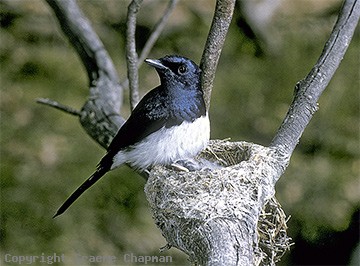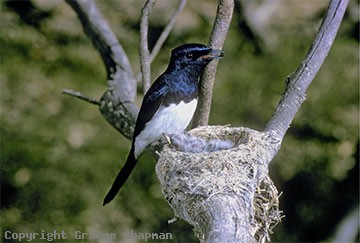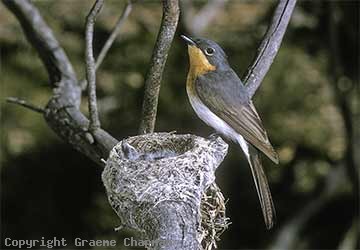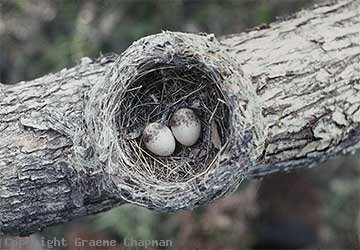
During the breeding season (Oct. - Mar.) Satin Flycatchers occur only in S.E. Australia - at lower altitudes in coastal Victoria and Tasmania, just reaching far S.E. South Australia, and further north all along the higher and cooler parts of the Great Dividing Range almost to Tenterfield in NSW. They are migratory and in the south, arrive arrive a fortnight or so later than Leaden Flycatchers, usually about the beginning of October. Like Leadens, they re-occupy much the same territories year after year. In pics #s 366001 and 366201 taken near Canberra the nest was actually built on the same fork as in the previous year - the remains of the old nest can be seen hanging to one side. Now that's what I call territorial fidelity! After nesting, they depart about the end of March or in April for northern Australia or beyond.
In Queensland, because only occasional records of birds on migration are made, few people will ever get an opportunity to see a Satin Flycatcher. Odd sightings come from forest country along the Great Dividing Range and sometimes from coastal regions but all these records should be viewed critically. Unfortunately, the illustrations of the males in all the field guides are inaccurate. They show the line of demarcation on the breast the same for both Leadens and Satins which is wrong - one curves upwards and the other downwards and this character alone constitutes the best field mark. (see under Leaden Flycatcher and also pics #s 366213D & 366214D). This error has lead to a lot of confusion, especially in those who have never seen a male Satin Flycatcher.
Females and young birds are actually more difficult to identify than males, particularly the young ones - they are probably only separable by measurement. Adult female Satin Flycatchers display a diagnostic bluish sheen on the crown which is plain grey in Leadens, not the easiest thing to see if you are looking from below. (see pics #s 366205 and 365215). The density and extent of the rufous colouring on the throat and breast is variable and not a reliable character ; adult Satins do tend to be darker than Leadens. They are also a bit darker on the back than female Leadens, but this is not easy to assess in the field.
Calls too are not diagnostic, mainly because there is such a wide repertoire, particularly in Leaden Flycatchers. Satins are probably a bit more strident and utter more of the harsh zzzzzzz-like calls - listen on the sound page.
Occasional sightings of "Satin" type flycatchers have been made in the Darwin area, but the Solomons (Steel Blue) Flycatcher is a very similar species and just as likely candidate.




